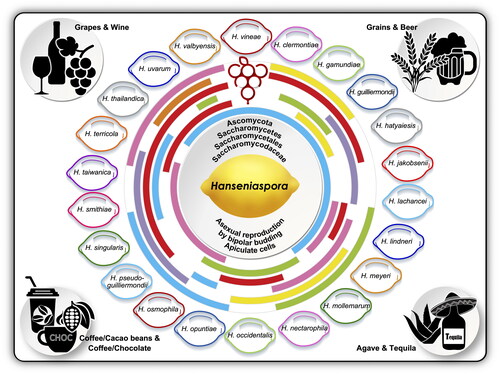Figures & data
Figure 1. Species belonging to the genus Hanseniaspora. These lemon-shaped yeasts are prevalent on ripe fruits and have been isolated from a diverse range of environments. Some of these apiculate species are associated with grapes and wine; grains and beer; agave plants and tequila; and cacao and coffee beans; as well as apple and pear cider.

Figure 2. A phylogenetic tree of members of the genus Hanseniaspora. Using maximum-likelihood analysis of the internal transcribed sequences of one representative of each Hanseniaspora species divides the genus into two large clades, a fast-evolving fruit clade and a slow-evolving fermentation clade. MEGA 11 software was used to draw the tree [Citation218].
![Figure 2. A phylogenetic tree of members of the genus Hanseniaspora. Using maximum-likelihood analysis of the internal transcribed sequences of one representative of each Hanseniaspora species divides the genus into two large clades, a fast-evolving fruit clade and a slow-evolving fermentation clade. MEGA 11 software was used to draw the tree [Citation218].](/cms/asset/04271103-88f9-4a14-8f90-3bd1e0cee9cc/ibty_a_2136565_f0002_c.jpg)
Figure 3. Effect of Hanseniaspora-initiated cultures in mixed-culture wine fermentations. Increases and decreases in metabolite concentrations are shown relative to the levels of those metabolites produced in fermentations conducted with a pure culture of Saccharomyces cerevisiae. References for Hanseniaspora uvarum [Citation67,Citation76,Citation85,Citation104,Citation219–224], Hanseniaspora guilliermondii [Citation31,Citation220,Citation221,Citation225], Hanseniaspora vineae [Citation68,Citation69,Citation75,Citation79,Citation85,Citation105,Citation226] and other Hanseniaspora species [Citation75,Citation223,Citation227–229].
![Figure 3. Effect of Hanseniaspora-initiated cultures in mixed-culture wine fermentations. Increases and decreases in metabolite concentrations are shown relative to the levels of those metabolites produced in fermentations conducted with a pure culture of Saccharomyces cerevisiae. References for Hanseniaspora uvarum [Citation67,Citation76,Citation85,Citation104,Citation219–224], Hanseniaspora guilliermondii [Citation31,Citation220,Citation221,Citation225], Hanseniaspora vineae [Citation68,Citation69,Citation75,Citation79,Citation85,Citation105,Citation226] and other Hanseniaspora species [Citation75,Citation223,Citation227–229].](/cms/asset/92343d20-c898-4a18-9296-d2bbfd8d92e1/ibty_a_2136565_f0003_c.jpg)
Figure 4. Biosynthesis pathways of fermentation-derived aroma compounds produced by grape-related Hanseniaspora species during winemaking [Citation14,Citation80].
![Figure 4. Biosynthesis pathways of fermentation-derived aroma compounds produced by grape-related Hanseniaspora species during winemaking [Citation14,Citation80].](/cms/asset/f73ccc1e-54ff-4b76-9f52-5f81b7369cda/ibty_a_2136565_f0004_c.jpg)
Figure 5. Effect of the deliberate addition of Hanseniaspora starter cultures on a diverse set of foodstuffs. References for beer [Citation4,Citation128,Citation129,Citation230–232], cocoa [Citation233–235], coffee [Citation236,Citation237], citrus [Citation238–240], apple [Citation241–245], tequila [Citation118,Citation246,Citation247], other [Citation248–252].
![Figure 5. Effect of the deliberate addition of Hanseniaspora starter cultures on a diverse set of foodstuffs. References for beer [Citation4,Citation128,Citation129,Citation230–232], cocoa [Citation233–235], coffee [Citation236,Citation237], citrus [Citation238–240], apple [Citation241–245], tequila [Citation118,Citation246,Citation247], other [Citation248–252].](/cms/asset/97697c3b-9a0f-47c4-9abc-213a1f730a64/ibty_a_2136565_f0005_c.jpg)
Table 1. Summary of biocontrol trials where Hanseniaspora strains were employed.
